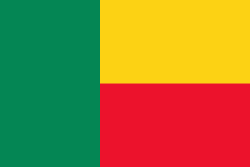Dangbo
Dangbo is a town, arrondissement, and commune in the Ouémé Department of south-eastern Benin.The commune covers an area of 340 square kilometres and as of 2002 had a population of 66,055 people. Dangbo is the site of Benin's Institute for Mathematics and Physical Sciences.
Dangbo is inhabited by the Wéménou people who constitute the bulk of its population. The Wéménou are an ethnic group that can be found today in the former administrative subdivision of Adjohoun, then stretching from Damey-Wogon to Gbodjè (Aguégués). It was split in 1978 into four (04) administrative districts which are: Bonou, Adjohoun, Dangbo, Aguégués. These populations lead a life punctuated by the presence of the Ouémé river, and share a common set of linguistic signs called Wémégbé. They are refugees made up of composite groups from the east: the Yoruba (the Tosso, the Glô, the Fênou, the Kénou, the Fongninou from the West, the Hounhouênou, the Houêdonou, and the Houédo-Sadonou from Fon-Adja language, from the North-West: the very important group of Wéménou proper descendant of an emblematic ancestor: Togbo-Hounsou who came to the Ouémé River Basin following their unexpected defeat in the hands of the soldiers of the Kingdom of Dahomey.
Dangbo is inhabited by the Wéménou people who constitute the bulk of its population. The Wéménou are an ethnic group that can be found today in the former administrative subdivision of Adjohoun, then stretching from Damey-Wogon to Gbodjè (Aguégués). It was split in 1978 into four (04) administrative districts which are: Bonou, Adjohoun, Dangbo, Aguégués. These populations lead a life punctuated by the presence of the Ouémé river, and share a common set of linguistic signs called Wémégbé. They are refugees made up of composite groups from the east: the Yoruba (the Tosso, the Glô, the Fênou, the Kénou, the Fongninou from the West, the Hounhouênou, the Houêdonou, and the Houédo-Sadonou from Fon-Adja language, from the North-West: the very important group of Wéménou proper descendant of an emblematic ancestor: Togbo-Hounsou who came to the Ouémé River Basin following their unexpected defeat in the hands of the soldiers of the Kingdom of Dahomey.
Map - Dangbo
Map
Country - Benin
 |
 |
| Flag of Benin | |
From the 17th to the 19th century, political entities in the area included the Kingdom of Dahomey, the city-state of Porto-Novo, and other states to the north. This region was referred to as the Slave Coast from the early 17th century due to the high number of people who were sold and trafficked during the Atlantic slave trade to the New World. France took over the territory in 1894, incorporating it into French West Africa as French Dahomey. In 1960, Dahomey gained full independence from France. As a sovereign state, Benin has had democratic governments, military coups, and military governments. A self-described Marxist–Leninist state called the People's Republic of Benin existed between 1975 and 1990. In 1991, it was replaced by the multi-party Republic of Benin.
Currency / Language
| ISO | Currency | Symbol | Significant figures |
|---|---|---|---|
| XOF | West African CFA franc | Fr | 0 |
| ISO | Language |
|---|---|
| FR | French language |















